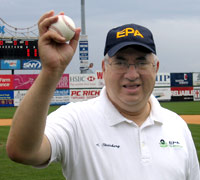The New Ball Game
Tuesday, May 20th, 2008About the author: Jeff Maurer manages Web content and does communications work for the Office of Solid Waste and Emergency Response. He has been with EPA since 2005.
 Before I moved to DC, I lived next to Wrigley Field, home of the Chicago Cubs. I love Wrigley Field – it’s like stepping back in time. The scoreboard is still manually operated. There are no billboards for advertising. They don’t play rock music over the PA system, though they do play polka music on the pipe organ during rain delays. You can still buy standing-room tickets at Wrigley, which is good because the seats were apparently installed when the average American was three feet tall and suffered from tapeworms.
Before I moved to DC, I lived next to Wrigley Field, home of the Chicago Cubs. I love Wrigley Field – it’s like stepping back in time. The scoreboard is still manually operated. There are no billboards for advertising. They don’t play rock music over the PA system, though they do play polka music on the pipe organ during rain delays. You can still buy standing-room tickets at Wrigley, which is good because the seats were apparently installed when the average American was three feet tall and suffered from tapeworms.
Compare that to recently-completed Nationals Park here in DC. Nationals Park boasts 41,888 American-sized seats (my description, not theirs), a 4,500 square foot high-definition scoreboard, and every other amenity you could possibly imagine. The fan experience is great, though their music choices tend to favor Fergie and Fall Out Boy, with surprisingly little polka.
It just goes to show how much attitudes and planning have changed. Fans in 2008 expect a lot when they come to a ballpark. They expect quality food. They expect not to sit behind a post. They expect to do the chicken dance (why?). As a result, the designers of Nationals Park had to consider a lot more than did the designers of Wrigley Field.
And finally – finally! – it seems that environmental impact is becoming a major consideration. Nationals Park is the first LEED-certified ballpark ![]() in Major League Baseball. It has several “green” features, including a plant-covered roof that reduces water runoff, an elaborate water filtration system, high-efficiency lighting, and low-flow plumbing fixtures. Compare that to Wrigley Field, which barely features plumbing.
in Major League Baseball. It has several “green” features, including a plant-covered roof that reduces water runoff, an elaborate water filtration system, high-efficiency lighting, and low-flow plumbing fixtures. Compare that to Wrigley Field, which barely features plumbing.
I’m glad that ballpark designers – and designers in general – are starting to figure this out. People in 1914 – the year Wrigley was built – didn’t care too much about the environment, but people in 2008 do. For example, people at public events expect to be able to recycle their empty bottles. I know this because EPA’s Recycle on the Go initiative – which encourages recycling at public events – has held several well-received events in public spaces, including at the 2006 Major League Baseball All-Star Game.
Attitudes and expectations change over time, sometimes for better (e.g., ballparks should have more than one bathroom), sometimes for worse (e.g., Lady Lumps is acceptable music during a pitching change). I think the message is clear: in 2008, the public expects environmentally-friendly buildings and spaces.

 As a baseball “nut,” I’ve been blessed. I grew up outside of Pittsburgh and rooted for the Pirates of Roberto Clemente. I also had great affection for a bunch of “Bums” from Brooklyn, including the courageous Jackie Roosevelt Robinson. In my adult years, I became a New York Mets fan. All’s right in my world when baseball is being played at Shea.
As a baseball “nut,” I’ve been blessed. I grew up outside of Pittsburgh and rooted for the Pirates of Roberto Clemente. I also had great affection for a bunch of “Bums” from Brooklyn, including the courageous Jackie Roosevelt Robinson. In my adult years, I became a New York Mets fan. All’s right in my world when baseball is being played at Shea.